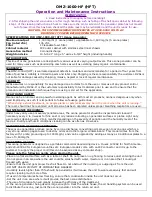
< Troubleshooting by using the self-diagnosis memory function>
·
By using the self-diagnosis memory function, you can check the failure mode (
Ć
1) occurring in the outdoor electrical
ǂ
parts on the indoor unit side.
Steps
1. Clear the troubleshooting data.
2. Run the product for several minutes under the conditions where the compressor runs.
3. Redisplay and check the data written in the self-diagnosis memory.
·
The self-diagnosis memory function can also be used to catch sporadic failure phenomena.
Steps
1. Clear the troubleshooting data.
2. Have the user use the product as usual until a failure phenomenon occurs.
ǂ
(The period depends on the incidence of the phenomenon.)
3. At a later date, redisplay and check the data written in the self-diagnosis memory.
·
For the outdoor self-diagnosis display (OH thermistor heat-up, overload lower limit cut) stemming from the freezing cycle
ǂ
or operating condition, the time lag is long from operation startup to the emergence of the phenomenon.
ǂ
Moreover, it is affected by the temperature, sunshine, operating hours, and other factors of the day, so that the
phenomenon may not be able to be identified at the time of a repair service visit. In that case too, use the self-diagnosis
memory function (
Ć
2).
·
The outdoor self-diagnosis display "overload lower limit cut" and "OH thermistor heat-up" can be identified only when you
are using the self-diagnosis lamp of the outdoor unit and the self-diagnosis memory function of the indoor unit.
Note that this will not be automatically displayed on the indoor unit side.
Initiating troubleshooting
Yes
Perform troubleshooting according to the
self-diagnosis display.
No
No
No
No
Ć
Ć
Ć
Are the "timer lamp" (orange) of the indoor unit
blinking?
The product will begin to run in response to a remote
control setting: "cooling mode, temperature setting 16
ć
"
(summer) or "heating mode, temperature setting 32
ć
"
(winter).
Has the "operation lamp" been turned on?
Yes
Yes
Yes
Check the indoor electrical parts.
Is the compressor running?
Turn off the power and turn on the power and
press the "forcible cooling" switch to operate the
product.
Has the compressor started to run?
Check the freezing cycle.
Check the outdoor electrical parts.
Diagnosis and troubleshooting of indoor electric parts
76
Summary of Contents for RAK-15QPC
Page 2: ... DANGER 2 ...
Page 24: ...24 ...
Page 25: ...RAK 15QPC RAK 18RPC RAK 25RPC 25 ...
Page 26: ...RAK 35RPC RAK RPC RAK 15QPC RAK 18RPC RAK 25RPC 50 26 ...
Page 27: ...27 ...
Page 28: ...28 ...
Page 31: ...WIRING DIAGRAM RAK 15QPC RAK 18RPC RAK 25RPC 31 ...
Page 33: ...CIRCUIT DIAGRAM MODEL 5 5 027 21752 6 1 RAK 15QPC POWER FOR CLEANNESS 33 ...
Page 34: ...CIRCUIT DIAGRAM MODEL 5 5 027 21752 6 1 RAK 18RPC RAK 25RPC POWER FOR CLEANNESS 34 ...
Page 67: ...68 67 ...
Page 70: ...37 and page 38 70 ...
Page 72: ...5 72 7 ...
Page 73: ...73 ...
Page 74: ... 䇭䇭 䇭䇭 䇭䇭 䇭䇭 䇭䇭 䇭䇭 B C E F 㺢 F 䌖 B GH E H C J E 74 ...
Page 75: ... 䇭䇭 G FK 㺢 F L M C B C M C E C B H C E B M C E C B M C 75 ...
Page 90: ...RAK 15QPC HHAW NO 0099E RAK 18RP RAK 25RP C C 90 ...















































